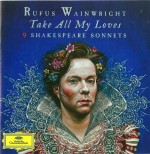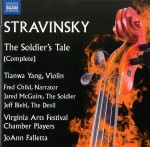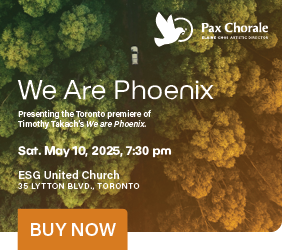 The first, Whenmill (Off ODG049 off-recordlabel.blogspot.ca), presents four pieces for solo baritone ukulele in a fairly traditional contemporary classical guitar idiom. The rich tones of the instrument and the way Choi makes full contrapuntal use of its limited range makes it easy to forget that he is dealing with two fewer strings than on a guitar. Set 1 is comprised of three pieces, Quixano and Inn Blue, both from 2012, and Whenmill, composed the following year. I wish there were some program notes for the pieces, but even web searches turn up little information. The opening piece’s title, also the honorific of “Don Quixote de la Mancha,” makes me wonder if Inn Blue refers to the Don’s infamous adventure at a country inn and whether Whenmill, a word I cannot find mention of except in connection with Choi, has something to with tilting at windmills…but that is mere speculation on my part. Regardless of intent or inspiration, the “set” is a satisfying and intriguing exploration of the potential of this lesser-known instrument. At 12 minutes, the final track, South Aleksandr, composed in 2011, is longer than the other three combined and its virtuosic flamenco-like passages showcase Choi’s considerable abilities.
The first, Whenmill (Off ODG049 off-recordlabel.blogspot.ca), presents four pieces for solo baritone ukulele in a fairly traditional contemporary classical guitar idiom. The rich tones of the instrument and the way Choi makes full contrapuntal use of its limited range makes it easy to forget that he is dealing with two fewer strings than on a guitar. Set 1 is comprised of three pieces, Quixano and Inn Blue, both from 2012, and Whenmill, composed the following year. I wish there were some program notes for the pieces, but even web searches turn up little information. The opening piece’s title, also the honorific of “Don Quixote de la Mancha,” makes me wonder if Inn Blue refers to the Don’s infamous adventure at a country inn and whether Whenmill, a word I cannot find mention of except in connection with Choi, has something to with tilting at windmills…but that is mere speculation on my part. Regardless of intent or inspiration, the “set” is a satisfying and intriguing exploration of the potential of this lesser-known instrument. At 12 minutes, the final track, South Aleksandr, composed in 2011, is longer than the other three combined and its virtuosic flamenco-like passages showcase Choi’s considerable abilities.
Review
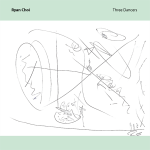 Choi’s other disc Three Dancers (Accretions ALP-060 accretions.com) is quite a different offering including works for “prepared” baritone ukulele, percussion and electronics, all performed by the composer. The title of the 20-minute EP, again about 20 minutes in all (and of the third track,) refers to Picasso’s painting Les Trois Danseuses and the cover art is a line drawing by Choi. The brief opening track Preparations I and IV is percussive in its approach, seemingly achieved with preparations on the ukulele similar to those which John Cage developed for piano, rather than through the use of traditional percussion instruments. It is very rhythmic and pointillistic, but relatively tame compared to the dynamic second track, Apollon at Eros, which combines hand drumming and stilted string plucking which jumps erratically, although not randomly, around the fret board. The electronic treatments are subtly present in Three Dancers, with, as far as I can tell, textures produced by reversing recorded sounds which actually seem almost as if they could be created live in real time by this accomplished player. These two releases present a remarkable portrait of an instrument not previously known for its art music potential, and of an adventurous new voice on the contemporary scene.
Choi’s other disc Three Dancers (Accretions ALP-060 accretions.com) is quite a different offering including works for “prepared” baritone ukulele, percussion and electronics, all performed by the composer. The title of the 20-minute EP, again about 20 minutes in all (and of the third track,) refers to Picasso’s painting Les Trois Danseuses and the cover art is a line drawing by Choi. The brief opening track Preparations I and IV is percussive in its approach, seemingly achieved with preparations on the ukulele similar to those which John Cage developed for piano, rather than through the use of traditional percussion instruments. It is very rhythmic and pointillistic, but relatively tame compared to the dynamic second track, Apollon at Eros, which combines hand drumming and stilted string plucking which jumps erratically, although not randomly, around the fret board. The electronic treatments are subtly present in Three Dancers, with, as far as I can tell, textures produced by reversing recorded sounds which actually seem almost as if they could be created live in real time by this accomplished player. These two releases present a remarkable portrait of an instrument not previously known for its art music potential, and of an adventurous new voice on the contemporary scene.
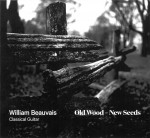 I was pleased, but not surprised, by the beautiful sounds on Old Wood – New Seeds, the latest from Toronto classical guitarist/composer William Beauvais (musiccentre.ca/node/138158). The disc opens with the suite, Appalachian Colours – Gold; Red; Green; Blue, evidently inspired not by Copland’s Appalachian Spring, but rather by that iconic American composer’s orchestral suite Rodeo. From the contemplative opening movement through the lilting second and the lullaby-like third, our attention is held by the lush colours Beauvais draws from his instrument. The gently ebullient final movement, glistening like sunlight off the surface of a rippling lake, held me wrapped in its thrall from start to finish nearly seven minutes later.
I was pleased, but not surprised, by the beautiful sounds on Old Wood – New Seeds, the latest from Toronto classical guitarist/composer William Beauvais (musiccentre.ca/node/138158). The disc opens with the suite, Appalachian Colours – Gold; Red; Green; Blue, evidently inspired not by Copland’s Appalachian Spring, but rather by that iconic American composer’s orchestral suite Rodeo. From the contemplative opening movement through the lilting second and the lullaby-like third, our attention is held by the lush colours Beauvais draws from his instrument. The gently ebullient final movement, glistening like sunlight off the surface of a rippling lake, held me wrapped in its thrall from start to finish nearly seven minutes later.
Shakespeare has arguably provided inspiration for more composers than any other literary figure throughout history. Beauvais has followed this time-honoured path with a pair of works, Fallstaffe’s Lament and Fallstaffe’s Charade, the first being a suitably mournful theme and variations and the second in the form of an English jig. No explanation is given for the aberrant spelling of the character’s name (nor for a different spelling, one “l” but still the “e,” in the program note), perhaps just to evoke the Elizabethan era before spellings were standardized. Certainly the music does so effectively. We’ll return to Shakespeare later in this column but Beauvais next takes us to Eastern Europe in The Ancient Waters suite which uses two Bulgarian songs and a rhythmic Balkan folk dance.
Beauvais incorporates Renaissance-style “divisions” in the warm and luscious Open Moonflower which is paired with the cascading Shoveling Clouds. Carré St. Anne, the final track on this very satisfying disc, begins quietly but gradually builds to a driving conclusion based on a Brazilian dance form. Throughout, the recorded sound is rich, but natural, and surprisingly free of extraneous finger and string noise.
Review
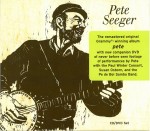 One thing I did not mention in the Beauvais review was that several of the tracks put me in mind of the Paul Winter Consort and how classical guitarist Ralph Towner was integrated into the fabric of that seminal crossover band in the 1970s. I mention this now because another package that found my attention this past month was a reissue of the 1996 CD Pete (LMUS 0032) along with the DVD Living Music Festival 1982 (LMU-45) featuring Pete Seeger and the Paul Winter Consort, on Winter’s Living Music label (paulwinter.com). Released 20 years ago when Seeger was 77, Pete – Pete Seeger and Friends brings together Joanie Madden (pennywhistle), Howard Levy (harmonica), Paul Winter (soprano sax), Paul Preston (banjo, mandolin) and three different choirs, Gaudeamus, the Union Baptist Church Singers and the Cathedral Singers, in 18 songs showing the breadth of Seeger’s interest and experience. From straightforward folk songs like Kisses Sweeter Than Wine, through protest, pro-environment and pro-humanity offerings, Garbage, To My Old Brown Earth and My Rainbow Race, and to storytelling, Huddie Ledbetter Was a Hell of a Man, and traditional songs like The Water is Wide, we are presented with many facets of one of the most influential folk singers of the 20th century, someone who brought so many people together over the course of a career that spanned almost eight decades.
One thing I did not mention in the Beauvais review was that several of the tracks put me in mind of the Paul Winter Consort and how classical guitarist Ralph Towner was integrated into the fabric of that seminal crossover band in the 1970s. I mention this now because another package that found my attention this past month was a reissue of the 1996 CD Pete (LMUS 0032) along with the DVD Living Music Festival 1982 (LMU-45) featuring Pete Seeger and the Paul Winter Consort, on Winter’s Living Music label (paulwinter.com). Released 20 years ago when Seeger was 77, Pete – Pete Seeger and Friends brings together Joanie Madden (pennywhistle), Howard Levy (harmonica), Paul Winter (soprano sax), Paul Preston (banjo, mandolin) and three different choirs, Gaudeamus, the Union Baptist Church Singers and the Cathedral Singers, in 18 songs showing the breadth of Seeger’s interest and experience. From straightforward folk songs like Kisses Sweeter Than Wine, through protest, pro-environment and pro-humanity offerings, Garbage, To My Old Brown Earth and My Rainbow Race, and to storytelling, Huddie Ledbetter Was a Hell of a Man, and traditional songs like The Water is Wide, we are presented with many facets of one of the most influential folk singers of the 20th century, someone who brought so many people together over the course of a career that spanned almost eight decades.
The DVD is a bit of a time capsule. Recorded at the Living Music Festival in 1982 when Seeger was a sprightly 63, the footage never saw the light of day until after his death in 2014 when Paul Winter sought out filmmaker Phil Garvin who fortunately still had the raw footage. The festival, organized by Winter in the Lichtfield Hills of northwest Connecticut, featured the Paul Winter Consort in selections from their album Common Ground, singer Susan Osborn and the Brazilian Pe de Boi Samba Band. Seeger performs an extended solo set singing in English, Yiddish, French and Spanish, accompanying himself on banjo, 12-string guitar and block flute. He also collaborates with the other performers and as you would expect there is lots of audience participation. It is vintage Seeger and a wonderfully nostalgic look at peace festivals of days gone by. There are bonus tracks recorded at the “Pete-nic” at Winter’s farm in 1997 and a five minute solo performance by Seeger for the Harriet Beecher Stowe Society in 2005 on the 40th anniversary of the “Bloody Sunday” Pettus Bridge March in Selma, Alabama. Although his voice had almost disappeared by that time, his energy and conviction had not flagged. It is a moving performance.
The CD/DVD set was supported by Music for the Earth, a non-profit foundation dedicated to “exploring ways that music can be used to enrich the lives of human beings and awaken a spirit of involvement in the preservation of wildlife and the natural environment of the Earth” – things to which Pete Seeger devoted his life and his art.
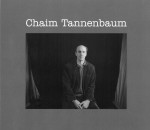 Chaim Tannenbaum is another who has been involved in the folk music scene for more than half a century, albeit in a peripheral role. Peripheral that is if you’re not part of the Wainwright/McGarrigle musical dynasty. The erstwhile professor of the philosophy of mathematics and logic has been an integral part of that extended family throughout the decades, managing to stay as friend and collaborator with both Loudon Wainwright III and Kate McGarrigle in spite of their breakup, frequently performing with Wainwright and with Kate and Anna McGarrigle and mentoring Loudon and Kate’s precocious offspring Rufus and Martha. Tannenbaum is a multi-instrumentalist with a distinctive voice who can be heard on many of the recordings of this family compact; his production credits include the album Therapy which marked Wainwright’s return to recording after a three-year hiatus in 1989.
Chaim Tannenbaum is another who has been involved in the folk music scene for more than half a century, albeit in a peripheral role. Peripheral that is if you’re not part of the Wainwright/McGarrigle musical dynasty. The erstwhile professor of the philosophy of mathematics and logic has been an integral part of that extended family throughout the decades, managing to stay as friend and collaborator with both Loudon Wainwright III and Kate McGarrigle in spite of their breakup, frequently performing with Wainwright and with Kate and Anna McGarrigle and mentoring Loudon and Kate’s precocious offspring Rufus and Martha. Tannenbaum is a multi-instrumentalist with a distinctive voice who can be heard on many of the recordings of this family compact; his production credits include the album Therapy which marked Wainwright’s return to recording after a three-year hiatus in 1989.
Evidently happy in the shadows, it took much persuasion from Tannenbaum’s friends to embark on this voyage to centre stage. His belated debut album includes a number of traditional pieces – Coal Man Blues, Moonshiner, Mama’s Angel Child – and the gospel song Farther Along and Harburg/Rose/Arlen’s It’s Only a Paper Moon. But it’s not all old-timey fare and Tannenbaum turns out to be a fine storytelling songwriter too – the CD opens out to a double panel with four paragraphs of prose I initially took to be a memoir, but which turn out to be the lyrics for his song Brooklyn 1955. The booklet includes extended encomiums by Wainwright (heard in harmony vocals on several tracks) and by record producer (not this record) Joe Boyd. Chaim Tannenbaum was produced by Dick Connette and released on StorySound Records (storysoundrecords.com). This disc is not just for aficionados of the Wainwright-McGarrigles, but it will be of particular interest to them. Highly recommended.
Concert note: Chaim Tannenbaum launches his eponymous CD at Toronto’s Tranzac Club on Sunday June 12.
Review
I told you that Shakespeare would reappear later and here he comes. April 23, 1616 is the assumed date of the death of the Bard and to mark the 400th anniversary Deutsche Grammophon has released Take All My Loves (4795508), a setting of nine Shakespeare Sonnets by the above-mentioned scion of the Wainwright-McGarrigle dynasty, Rufus Wainwright. It is an eclectic offering, further exploring the singer-songwriter’s interest in blending the worlds of pop and high-art culture. There are readings by Siân Phillips, Frally Hynes, Peter Eyre, Carrie Fisher, William Shatner and Inge Keller, while the vocals are primarily shared by Austrian soprano Anna Prohaska and Wainwright himself, with the participation of Florence Welsh, Martha Wainwright, Fiora Cutler, Christopher Nell and Jürgen Holtz.
The project grew out of an invitation from director Robert Wilson back in 2009 – the 400th anniversary of the publication of the sonnets – to set some of them for a production of the Berliner Ensemble, a theatre company founded by Bertold Brecht in 1949. Although Wainwright’s interest in the poems dates back to his youth when he was encouraged to read them by his mother, they have been of ongoing interest in recent years. Following the cabaret style production in Berlin replete with garish costumes, the San Francisco Symphony commissioned Wainwright to orchestrate five of the sonnets for the concert hall, three of which appeared on his 2010 album All Days Are Nights: Songs for Lulu.
The current production is kind of a mixed bag, with lush full orchestral accompaniments featuring the BBC Symphony Orchestra, smaller settings with the Berlin String Section and a number of tracks with pop band instrumentation. All of the sung sonnets are introduced by a dramatic reading of the text, with the exception of Wainwright’s performance of Take All My Loves (Sonnet 40) which incorporates Marius de Vries’ recitation into the body of the song. Prohaska’s voice, celebrated across a repertoire that spans three centuries, is a highlight, especially in the gentle A Woman’s Face (Sonnet 20) and the wickedly dramatic Th’Expense of Spirit in a Waste of Shame (Sonnet 129). Wainwright’s distinctive voice is particularly effective in the title track, but his reprise of A Woman’s Face is something of a letdown with its straightforward pop arrangement and sensibility.
The extensive booklet includes an introduction by British actor Peter Eyre, full texts, translations and production credits. What is missing is an explanation of why two of the sonnets are presented in German necessitating the translations, or more properly the English originals, of All Dessen Müd (Sonnet 66) in a cabaret-like arrangement and Farewell (Sonnet 87) sung beautifully by Prohaska. I assume this has to do with the Berliner Ensemble origins of the settings, but it would have been nice if Eyre, whose English performance of Farewell with Wainwright can be found on YouTube, would have explained.
Concert note: Toronto audiences can catch Rufus Wainwright’s acclaimed recreation of Judy Garland’s 1961 Carnegie Hall show “Rufus Does Judy” June 23 and 24 at the Hearn Generating Station as part of this year’s Luminato Festival.
Review
Concert note: On June 18 another Luminato performance at the Hearn features soloists of the Toronto Symphony Orchestra with concertmaster Jonathan Crow and narrator Derek Boyes in Stravinsky’s L’Histoire du Soldat. Naxos recently released a new recording of that work, Stavinsky – The Soldier’s Tale (Complete) featuring the Virginia Arts Festival Chamber Players with violinist Tianwa Yang, narrator Fred Child and actors Jared McGuire (The Soldier) and Jeff Biehl (The Devil) under the direction of JoAnn Falletta (8.573537).
I have always liked this pocket drama – an hour-long Faustian story of a young man who sells his soul – or in this case his violin – to the devil and in so doing loses the things and people he loves. Composed in 1917 while Stravinsky was living in Switzerland during the First World War, it is scored for a modest orchestra of seven players reflecting the ravaged ranks of musicians who survived that conflict. Of principal interest is the violin, so dear to the soldier – its themes will reappear in Stravinsky’s Violin Concerto some 14 years later. It is a different take on the story because it is not the soldier’s greed which leads him to his fateful error. He is actually perfectly content with his modest life and his fiddle but is tricked by the devil into making the trade. Although granted fortune through the book he trades for, which foretells the future, it was never his idea and he is never comfortable in the role. Eventually he finds a way to beat the devil – by letting him win at cards – and regain his life. Spoiler Alert: all does not end well when you play with the devil and in a scene reminiscent of Orpheus’ glance back at Eurydice, the devil regains the upper hand and the violin.
The story is narrated effectively and Yang’s violin playing is flawless and convincing in this new performance. It is a welcome addition to my collection.
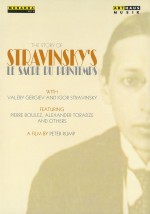 And a quick final note. The Story of Stravinsky’s Le Sacre du Printemps with Valery Gergiev (ArtHaus Music 109210) is a very effective documentary film by Peter Rump. Gergiev leads the Rotterdam Philharmonic Orchestra through a rehearsal during which he analyzes and explains his approach to the iconic work. This is intercut with commentary and piano examples by Gergiev and historic footage of Stravinsky, Pierre Boulez and Alexander Toradze. Gergiev makes a very strong case for his interpretation – rough and rhythmic, rather than romantic – and provides an insightful introduction that shows how this 100-year-old masterwork is still fresh and vibrant.
And a quick final note. The Story of Stravinsky’s Le Sacre du Printemps with Valery Gergiev (ArtHaus Music 109210) is a very effective documentary film by Peter Rump. Gergiev leads the Rotterdam Philharmonic Orchestra through a rehearsal during which he analyzes and explains his approach to the iconic work. This is intercut with commentary and piano examples by Gergiev and historic footage of Stravinsky, Pierre Boulez and Alexander Toradze. Gergiev makes a very strong case for his interpretation – rough and rhythmic, rather than romantic – and provides an insightful introduction that shows how this 100-year-old masterwork is still fresh and vibrant.
Shameless self-promotion II: I am hosting a fundraiser on behalf of New Music Concerts at “Coffee House 345” (aka Gallery 345 on Sorauren) on Wednesday June 15. I will be bringing my eclectic repertoire, 6- and 12-string guitars and a few musical friends along for the ride. Thanks to NMC’s board of directors there will be complimentary snacks and libations. For reservations call 416-961-9594.
We welcome your feedback and invite submissions. CDs and comments should be sent to: DISCoveries, WholeNote Media Inc., The Centre for Social Innovation, 503 – 720 Bathurst St. Toronto ON M5S 2R4. We also encourage you to visit our website thewholenote.com where you can find added features including direct links to performers, composers and record labels, “buy buttons” for on-line shopping and additional, expanded and archival reviews.
David Olds, DISCoveries Editor
discoveries@thewholenote.com


